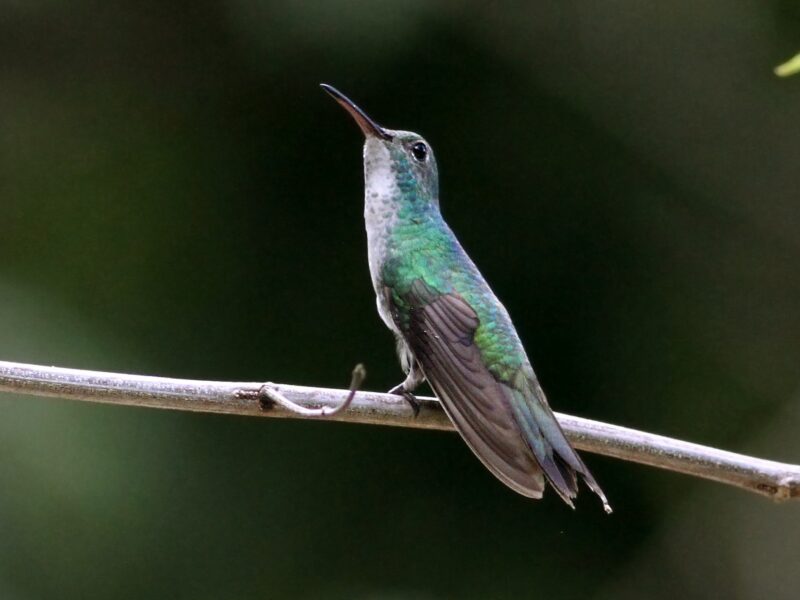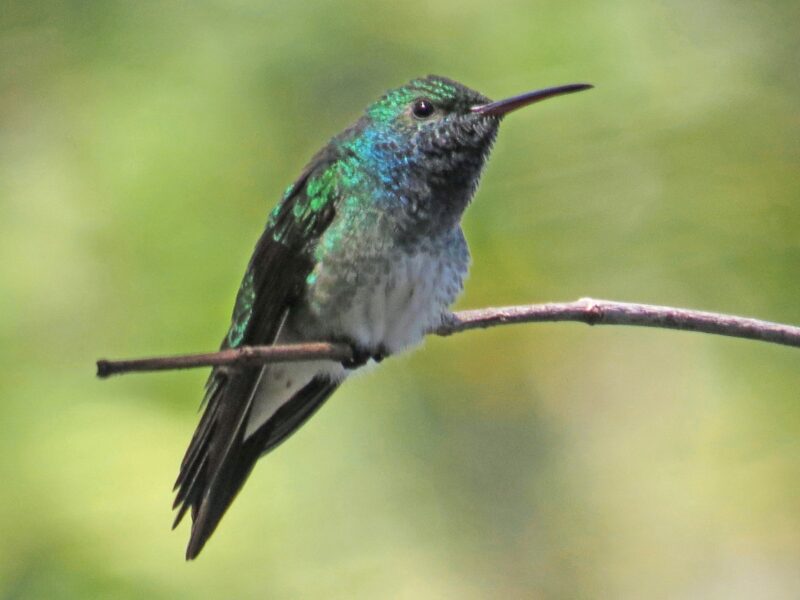The Mangrove Hummingbird of Costa Rica
This specie (Amazilia boucardi) can only be found in Costa Rica in Central America, unfortunately, they are classified as endangered with an estimated population of 2,500 to 10,000 birds. Their numbers are declining due to the destruction of their mangrove habitat caused by the construction of Salinas and shrimp ponds, illegal cutting, road construction and pollution. Even though they primarily live in subtropical or tropical mangrove forests; they are occasionally seen in adjacent non-mangrove habitats.
Description

This medium-sized, mostly bronze and green hummingbird averages 9.5 – 11 cm in length (including its tail) and weighs around 4.5 grams. Its bill measures about 18 mm long and is mostly straight except for a slight curve. The upper bill is blackish, while the lower bill is reddish in colour.
The male’s upper plumage is mostly bronze-green. The throat and chest are a glittering bluish-green, and feathers toward the chin have prominent white lines. The abdomen is whitish with bronze-green sides. The under-tail feathers are whitish. The slightly forked tail is mostly bronzy-green. The female is similar with a primarily white under-plumage except for a little green spotting on the throat and sides. The female’s outermost rectrices (flight feathers) have greyish tips. Immature look like the female in throat colouration, and their under plumage is more greyish than that of the adults.
Similar Species
The Mangrove Hummingbird resembles the Charming Hummingbird (Polyerata decora) except the bill of the Charming is straighter than the Mangrove Hummingbird. Also, the Charming has a violet-blue chest, while the Mangrove’s is bluish-green.
Mangrove Hummingbirds can also be easily confused with the Snowy-breasted Hummingbird (Saucerottia edward) which has an adjacent range yet not overlapping with that of the Mangrove. The males of both species are mostly green with white abdomen. However, in the male Snowy-breasted Hummingbird, the contrast between the green throat and the white abdomen is clearer. Also, the Snowy-breasted ‘s tail is black, while the Mangrove’s is bronzy green. In addition, the Snow-breasted ‘s rump is green to coppery green, while the Mangrove’s is coppery bronze. The bill of the Mangrove Hummingbird is also slightly larger than that of the Snowy-breasted.
Nesting-Breeding

Their breeding season usually stretches from October through February. The female Mangrove Hummingbird alone constructs the cup-shaped nest using various plant fibers woven together. The nest structure is strengthened with spider webbing and other sticky material, giving it an elastic quality to allow it to stretch to double its size as the young grow and require more space. The nest is lined with soft plant fibers, animal hair and feather down.
On the outside of the nest, she attaches green moss for camouflage. The nest is usually hidden in a shrub, bush or tree, where it is usually placed on a low, thin horizontal branch.
An average clutch consists of 2 white eggs, which are incubated by the female alone. The chicks are born blind, immobile and without any down. The female alone protects and feeds the chicks with regurgitated food (mostly partially-digested insects since nectar is an insufficient source of protein for the growing chicks). The female pushes the food down the chicks’ throats with her long bill directly into their stomachs. As is the case with other hummingbird species, the chicks are brooded only the first week or two and are left alone even on cooler nights after about 12 days – probably due to the small nest size. The chicks leave the nest when they are about 7 – 10 days old.
Diet
They primarily feed on nectar taken from a variety of brightly coloured, scented small flowers of trees, herbs, shrubs and epiphytes although favouring a flower known as the Tea Mangrove (Pelliciera Rhizophorae).
Link: https://beautyofbirds.com/
